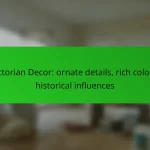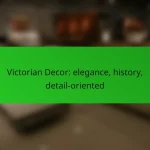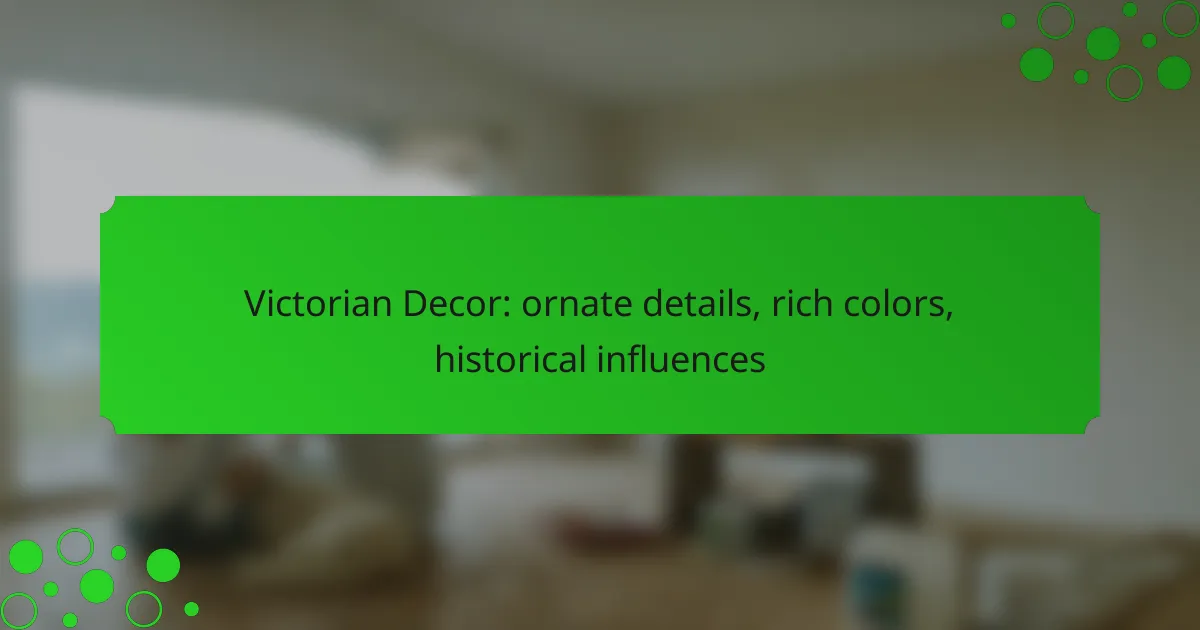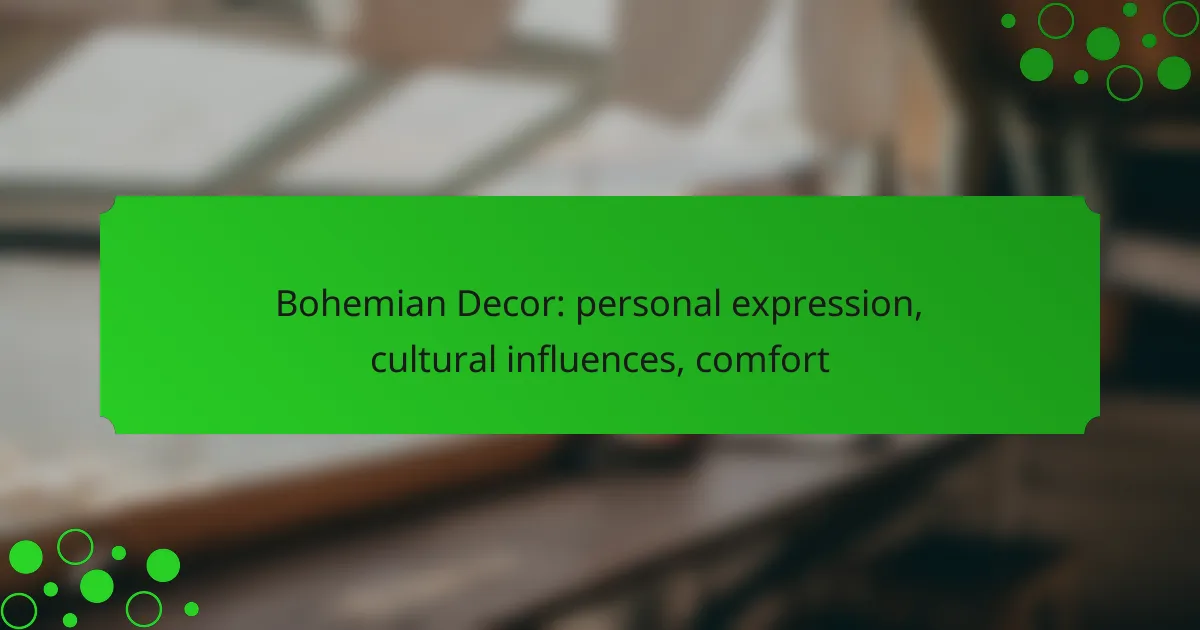Victorian decor is a celebration of ornate details, rich colors, and historical influences that evoke the elegance of the 19th century. By blending intricate patterns and luxurious materials, this style creates a warm and inviting atmosphere that transports you to a bygone era. Embracing Victorian elements in your home allows for a unique expression of opulence and complexity, making each space truly distinctive.

How to incorporate Victorian decor in your home?
Incorporating Victorian decor in your home involves embracing ornate details, rich colors, and historical influences that define this elegant style. Focus on blending these elements harmoniously to create a warm, inviting atmosphere reminiscent of the Victorian era.
Use rich color palettes
Victorian decor is characterized by deep, saturated colors that evoke a sense of luxury. Consider using shades like burgundy, emerald green, navy blue, and gold to create a dramatic backdrop in your rooms.
To achieve a cohesive look, balance these rich hues with lighter accents, such as cream or soft pastels. This contrast will enhance the overall aesthetic and prevent the space from feeling too dark or heavy.
Choose ornate furniture styles
Opt for furniture that showcases intricate carvings, curved lines, and plush upholstery. Pieces made from dark woods like mahogany or walnut often embody the Victorian style, providing both elegance and durability.
Look for items such as tufted sofas, wingback chairs, and elaborately designed tables. Mixing different styles can also add character, but ensure that the overall theme remains consistent with Victorian influences.
Add decorative moldings
Incorporate decorative moldings to enhance the architectural details of your home. Crown moldings, wainscoting, and ceiling medallions can add depth and sophistication to any room.
Choose designs that feature intricate patterns or floral motifs to stay true to the Victorian aesthetic. Painting these moldings in contrasting colors can further highlight their beauty and make a striking visual impact.
Incorporate vintage textiles
Textiles play a crucial role in Victorian decor, with rich fabrics like velvet, brocade, and damask being popular choices. Use these materials for curtains, upholstery, and throw pillows to add texture and warmth to your space.
Layering different fabrics can create a cozy atmosphere. Consider mixing patterns and textures, but keep a harmonious color scheme to maintain a unified look throughout the room.
Utilize antique accessories
Antique accessories are essential for completing a Victorian decor scheme. Look for items such as ornate mirrors, vintage lamps, and decorative vases that reflect the era’s craftsmanship and style.
Incorporate these pieces thoughtfully, ensuring they complement your furniture and textiles. A few well-placed antiques can serve as focal points, drawing attention and adding character to your home.

What are the key characteristics of Victorian decor?
Victorian decor is characterized by its ornate detailing, rich colors, and an eclectic mix of styles that reflect the historical influences of the Victorian era. This design aesthetic emphasizes opulence and complexity, often incorporating intricate patterns and luxurious materials.
Ornate detailing
Ornate detailing is a hallmark of Victorian decor, featuring intricate carvings, elaborate moldings, and decorative elements such as lace and fringe. Furniture often showcases elaborate woodwork, with designs that include floral motifs and scrollwork.
When selecting Victorian-style pieces, look for items with rich textures and embellishments. Consider using wallpaper with damask patterns or fabrics like velvet and brocade to enhance the ornate feel of the space.
Rich, deep colors
Victorian decor favors rich, deep colors that evoke a sense of warmth and luxury. Common color choices include burgundy, forest green, navy blue, and gold, often used in combination to create a dramatic effect.
To achieve this look, paint walls in darker shades and complement them with lighter furniture or accessories. Incorporating jewel-toned fabrics for upholstery or drapery can also enhance the richness of the decor.
Eclectic mix of styles
The Victorian era embraced an eclectic mix of styles, drawing inspiration from Gothic, Renaissance, and even Asian influences. This blend creates a unique and personalized aesthetic, allowing for a variety of textures and forms within a single space.
To incorporate this eclecticism, mix and match furniture pieces from different periods or styles. Pair a Victorian settee with a modern coffee table, or use decorative accents from various cultures to create a cohesive yet diverse environment.

Where to find Victorian decor items in the UK?
Victorian decor items can be found in various places across the UK, including specialty antique shops, online marketplaces, and local flea markets. Each option offers unique finds and varying price ranges, making it easier to discover authentic pieces that reflect the ornate details and rich colors of the Victorian era.
Specialty antique shops
Specialty antique shops are excellent sources for authentic Victorian decor. These shops often curate collections that include furniture, textiles, and decorative items from the Victorian period, ensuring quality and historical accuracy.
When visiting these shops, look for items with original features, such as intricate carvings or original upholstery. Prices can vary widely, often ranging from a few hundred to several thousand pounds, depending on the item’s rarity and condition.
Online marketplaces like eBay
Online marketplaces, particularly eBay, provide a vast selection of Victorian decor items. You can find everything from small decorative pieces to larger furniture items, often at competitive prices.
When shopping online, check seller ratings and read descriptions carefully to ensure authenticity. Bidding can lead to lower prices, but be prepared for the possibility of items being misrepresented, so always review return policies.
Local flea markets
Local flea markets can be treasure troves for Victorian decor enthusiasts. These markets often feature vendors selling a mix of antiques, vintage items, and handmade goods, allowing for unique finds at potentially lower prices.
While exploring flea markets, negotiate prices and inspect items closely for quality. Prices can range from a few pounds for smaller items to hundreds for larger pieces, making it a budget-friendly option for collectors.

What are the historical influences on Victorian decor?
Victorian decor is heavily influenced by various historical movements, reflecting the cultural and technological changes of the 19th century. Key influences include the Industrial Revolution, Gothic Revival architecture, and the Arts and Crafts movement, each contributing unique elements to the ornate style characteristic of the era.
Industrial Revolution impact
The Industrial Revolution transformed production methods, leading to the availability of new materials and techniques that shaped Victorian decor. Mass production allowed for intricate designs to be created in furniture, textiles, and decorative items, making them more accessible to the middle class.
This period saw the introduction of synthetic dyes, which enabled a wider palette of rich colors in fabrics and wallpapers. The use of cast iron and machine-made components also became prevalent, adding to the ornate detailing that defined Victorian interiors.
Gothic Revival architecture
The Gothic Revival movement significantly influenced Victorian decor, emphasizing vertical lines, pointed arches, and intricate detailing. This architectural style inspired interior design elements such as elaborate moldings, stained glass windows, and heavy drapery, creating a dramatic and romantic atmosphere.
Victorian homes often featured elements like turrets and gables, reflecting the grandeur of Gothic cathedrals. The incorporation of dark woods and rich fabrics further enhanced the opulent feel typical of this style.
Arts and Crafts movement
The Arts and Crafts movement emerged as a reaction against industrialization, promoting handcrafted goods and simplicity in design. This influence encouraged a focus on quality materials and craftsmanship, leading to a more personalized approach in Victorian decor.
Key characteristics included natural motifs, earthy colors, and an emphasis on functional beauty. Furniture and decor from this movement often featured simple lines and organic shapes, providing a counterbalance to the more ornate aspects of Victorian design.

How to choose the right Victorian decor for your space?
Choosing the right Victorian decor involves understanding the style’s ornate details, rich colors, and historical influences. Focus on elements that enhance the character of your space while ensuring they fit well within your existing environment.
Consider room size and layout
The size and layout of your room significantly affect your Victorian decor choices. In smaller spaces, opt for fewer large pieces to avoid overwhelming the area, while larger rooms can accommodate more elaborate furnishings and decorations.
Use rich colors and intricate patterns to create a cozy atmosphere in smaller rooms. For larger spaces, consider using a mix of bold and subtle elements to maintain balance and visual interest.
Match decor to existing architecture
Aligning your Victorian decor with the existing architecture of your home is crucial for a cohesive look. If your home features original Victorian elements, such as crown molding or fireplaces, highlight these with complementary decor choices.
For modern homes, incorporate Victorian-inspired pieces that echo the style without clashing. Look for furniture and accessories that reflect the ornate details typical of the Victorian era, such as intricate carvings or rich fabrics, to create a harmonious blend.









